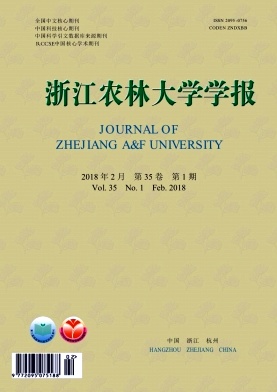-
土壤酸化是中国土壤面临的主要问题之一,也是土壤退化的一个重要特征。据报道,中国南方经济作物土壤的pH值自20世纪80年代至今平均下降了0.3[1]。土壤酸化容易导致土壤结构差、肥力低且有毒重金属含量过度积累,影响作物生长发育,严重威胁粮食安全及生态系统可持续发展。集约经营模式被认为是导致土壤酸化的重要因素之一[2]。雷竹Phyllostachys violascens是一种优良笋用竹种,在浙江省境内广泛栽植。近年来,冬季以地表覆盖增温和大量施用肥料为核心技术的雷竹早产高效经营模式得到大面积推广和应用[3]。这种长期集约经营模式虽然给当地农户带来了显著的经济效益,但由于缺乏科学管理,也产生了一系列生态环境问题,如土壤酸化、养分流失、增加面源污染[4],干扰了土壤微环境,导致土壤微生态失衡、微生物多样性衰退[2]、土壤酶活性明显降低[5],从而直接或间接地引起雷竹林提前退化。大量化学氮肥施用易造成雷竹林土壤铵态氮硝化加速,硝酸盐淋溶;高温高湿过程促进覆盖物分解产生腐殖酸和有机酸使得盐基饱和度降低,交换性酸总量增加。酸化也促使土壤中重金属元素有效态含量明显提高,从而抑制土壤微生物繁殖和活性[2]。针对雷竹林土壤退化的主要成因,研究者们相继提出了施用石灰和石灰氮等手段[6]。然而,长期施用石灰易引起养分失衡、土壤板结,特别是导致土壤有机质含量下降[7]。石灰氮虽然可以短期内缓解雷竹林土壤酸化并控制土传病害,但是强烈地抑制了土壤微生物生物量和酶活性[6]。因此,寻找一种既能中和土壤酸度、提高土壤肥力,又能恢复土壤微生态平衡,促进土壤微生物繁殖及活性的理想改良剂,对提高酸化土壤的生产力和生态环境的保护具有双重意义。随着生物质炭技术的发展,将生物质废弃物热解成生物质炭进行土壤应用被认为是当前国际应对气候变化、增强土壤碳汇的新途径[8]。生物质炭因其较大的表面积和较高的孔隙度而具有良好的重金属和有机污染物吸附能力[9]。生物质炭较高的pH值可以中和土壤酸性;其表面带有负电荷,具有较高的阳离子交换量,可以提高土壤肥力,降低铝对作物的毒害作用[10]。不仅如此,生物质炭还能有效提高土壤微生物的生物量,提高细菌类群多样性[11]。然而,不同原料制备的生物质炭物理、化学性质差异较大[12],施入土壤后对土壤酸化改良效果和对微生物群落结构和活性影响也可能存在较大差异。中国农林废弃物资源庞大,但是利用率普遍较低。据估计,仅农业就产生超过7亿t·a-1作物秸秆生物量,其中有1/4的秸秆就地燃烧[13];竹材加工业对竹材的利用率仅约40%[14];仅杭州市临安区产生的山核桃Carya cathayensis蒲壳多达5万t·a-1[15],相当大一部分山核桃蒲壳被随意丢弃和焚烧,造成资源的浪费和环境污染。针对上述情况,将农林废弃物热解成生物质炭加以应用,是废弃物资源化有效手段,也是本研究的立足点。利用不同原料生物质炭对雷竹林酸化土壤进行改良的研究还未见报道。因此,本研究通过分析不同原料生物质炭对土壤养分、酸度、微生物丰度和酶活性影响,比较不同原料生物质炭对酸化雷竹林土壤的化学和生物学改良效果,为农林废弃物资源化利用和酸化土壤修复提供理论参考。
HTML
-
供试土壤采自浙江省杭州市临安区板桥镇(30°14′N,119°42′E)。该区属亚热带季风气候,年平均气温为15.9 ℃,年降水量为1 350~1 500 mm,年日照时数1 774 h,无霜期236 d。土壤类型属于粉砂岩母质上发育的红壤土类。选择集约经营超过10 a的雷竹林样地,与相邻区域未集约经营林地相比,该样地pH值下降了1.0~1.5个单位。于2015年4月设置10 m × 10 m样地,随机取样法采集0~20 cm土壤样品5份,混合均匀,自然风干后过2 mm筛备用。供试土壤基本性质见表 1。
供试材料 pH(H2O) 有机碳/(g·kg-1) 全氮/(g·kg-1) 碳氮比 表面积/(m2·g-1) 灰分/% 产率/% 土壤(ck) 5.10 17.40 1.72 10.23 - - - 玉米秸秆炭(CB) 9.48 436.81 9.53 56.38 2.61 13.69 32 竹炭(BB) 9.32 135.62 4.31 191.05 0.89 8.65 59 山核桃蒲壳炭(PB) 10.26 337.10 5.24 106.46 2.58 11.22 45 Table 1. Selected properties of soil and biochars pyrolyzed from different feedstocks
收集玉米Zea mays秸秆、竹材边角料和山核桃蒲壳,自然风干后,剪成小块,置于特制的密闭容器中,放于马弗炉中350 ℃下限氧热裂解4 h制得不同原料生物质炭。制得的生物质炭通过1 mm筛,混合均匀后备用。供试玉米秸秆炭、竹炭和山核桃蒲壳炭的基本性质见表 1。
-
试验设4个处理:对照(不加生物质炭,ck),添加质量分数为2%玉米秸秆炭(CB),添加质量分数为2%竹炭(BB)和添加质量分数为2%山核桃蒲壳炭(PB),重复3次·处理-1。将生物质炭样品与土壤充分混合后装入塑料盆中,盆的位置随机摆放。播种大小均匀饱满的种子20粒·盆-1,等黑麦草Lolium perenne种子萌发1周后,间苗至10株·盆-1。用去离子水调节土壤湿度至约60%田间最大持水量。盆栽试验培养时间为90 d,培养期间不添加肥料,定期补充去离子水。盆栽90 d后剪取黑麦草地上部分,置于60 ℃烘箱中烘干至恒量,称量。
-
盆栽结束后采集土壤样品,过2 mm筛,混匀,分成3份。1份自然风干,用于土壤基本性质测定;1份放在4 ℃冰箱保存,用于土壤酶活性分析、铵态氮(NH4+-N)和硝态氮(NO3--N)测定;剩余的1份冷冻干燥后保存至-70 ℃冰箱。土壤pH值,有机碳(SOC),全氮(TN),铵态氮和硝态氮分析参照鲁如坤[16]的方法。土壤交换性酸采用1 mol·L-1氯化钾溶液淋洗,碱滴定法测定[16]。
-
土壤总DNA提取采用MOBIO公司生产的土壤DNA提取试剂盒(PowerSoil DNA Isolation Kit,美国),按试剂盒说明书进行。用质量浓度为1.0%的琼脂糖凝胶电泳检测提取后的DNA样品,采用微量分光光度计(ND-1000,NanoDrop Technologies,美国)测定其浓度和纯度。以土壤细菌16S rDNA和真菌18 S rDNA为目的基因,采用通用引物(细菌:338F/518R[17],真菌:NS1F/FungR[18])在荧光定量聚合酶链式反应(PCR)仪CFX96TM Real-Time System(Bio-Rad,美国)上进行基因扩增。反应体系、质粒及标准曲线的制作参照文献[11]进行。
-
土壤脱氢酶和β-葡萄糖苷酶活性分析分别采用氯化三苯基四唑还原法和硝基酚比色法测定,结果分别以三甲基甲臜(TPF,μg·g-1·h-1)和对硝基酚(PNP,μg·g-1·h-1)表示。土壤纤维二糖苷酶、亮氨酸氨基肽酶和酸性磷酸酶活性分析采用微孔板荧光法[19],重复3次·样品-1,同时设置不加标准物质的对照。用多功能酶标仪(SynergyTM H1, Biotek,美国)在荧光激发光365 nm和检测光波长450 nm下测定反应液荧光值,单位为nmol·g-1·h-1。
-
所得数据采用SPSS 18.0软件进行单因素方差分析(ANOVA),Duncan法多重比较检验各处理间的差异显著性,相关性分析采用皮尔逊(Pearson)相关分析法进行双尾检验确定显著性。
1.1. 供试材料
1.2. 试验设计
1.3. 土壤化学、生物学性质分析
1.4. 土壤总DNA提取和微生物丰度定量PCR分析
1.5. 土壤酶活性分析
1.6. 数据处理与统计分析
-
由表 2可知:培养结束后,玉米秸秆炭(CB)和山核桃蒲壳炭(PB)处理下黑麦草生物量显著高于对照(ck),增幅分别为43%和61%;而竹炭(BB)处理与对照无显著差异。与ck相比,CB,BB和PB处理均显著提高了土壤有机碳质量分数,增幅分别为35%,19%和50%。CB和PB显著提高了土壤全氮质量分数,BB处理未显著改变全氮质量分数,但显著提高了碳氮比。与ck相比,仅PB处理显著增加了硝态氮质量分数;3种生物质炭处理均显著降低了土壤铵态氮质量分数,其中PB降幅最大。
处理 黑麦草生物量/g 有机碳/(g·kg-1) 全氮/(g·kg-1) 碳氮比 硝态氮/(mg·kg-1) 铵态氮/(mg·kg-1) 对照(ck) 2.08 ± 0.22 c 18.07 ± 1.26 c 1.72 ± 0.03 b 10.51 ± 0.70 b 9.74 ± 2.00 bc 13.69 ± 1.78 a 玉米秸秆炭(CB) 2.98 ± 0.62 ab 24.40 ± 0.39 ab 2.34 ± 0.15 a 10.46 ± 0.79 b 7.57 ± 1.12 c 8.13 ± 1.35 b 竹炭(BB) 2.63 ± 0.06 bc 21.58 ± 1.60 b 1.66 ± 0.03 b 13.02 ± 1.15 a 12.33 ± 1.77 ab 9.74 ± 1.37 b 山核桃蒲壳炭(PB) 3.35 ± 0.19 a 27.04 ± 2.40 a 2.26 ± 0.15 a 11.98 ± 0.72 ab 13.54 ± 1.10 a 3.46 ± 1.31 c 说明:表中数据为平均值±标准差(n=3),同列数据不同字母表示差异显著(P < 0.05)。 Table 2. Changes in ryegrass biomass and soil nutrient contents with addition of biochars pyrolyzed from different feedstocks
-
如表 3所示:与ck相比,CB和PB处理均显著提高了土壤pH值,增幅分别为18%和17%,而BB处理与ck无显著差异。3种生物质炭处理均显著降低了交换性氢质量摩尔浓度,其中降幅为CB>PB>BB,而仅CB和PB显著降低了交换性铝(降幅分别为81%和35%)和交换性酸总量(降幅分别为69%和36%)。
处理 pH(H2O) 交换性氢/(cmol·kg-1) 交换性铝/ (cmol·kg-1) 交换性酸总量/(cmol·kg-1) 对照(ck) 5.18 ± 0.18 b 1.02 ± 0.17 a 1.18 ± 0.26 a 2.20 ± 0.11 a 玉米秸秆炭(CB) 6.13 ± 0.10 a 0.46 ± 0.08 c 0.22 ± 0.07 c 0.68 ± 0.13 c 竹炭(BB) 5.53 ± 0.10 b 0.80 ± 0.06 b 1.33 ± 0.04 a 2.14 ± 0.06 a 山核桃蒲壳炭(PB) 6.05 ± 0.42 a 0.63 ± 0.05 bc 0.77 ± 0.08 b 1.40 ± 0.13 b 说明:表中数据为平均值±标准差(n=3),同列数据不同字母表示差异显著(P < 0.05)。 Table 3. Changes in soil pH and exchangeable acid content with addition of biochars pyrolyzed from different feedstocks
-
不同原料生物质炭处理下土壤真菌和细菌基因丰度如图 1所示。不同处理间真菌18S rRNA基因拷贝数为3.80×109~7.64×109,其中CB处理显著高于ck,提高幅度为53%,而其他处理与ck无显著差异。不同处理间细菌16S rRNA基因拷贝数比对应的真菌高1个数量级,为1.88×1010~4.66×1010,CB处理与ck无显著差异,而BB和PB处理均显著高于ck。不同处理对应的真菌细菌比与对照均无显著差异,而CB处理显著高于BB和PB处理。由表 4可知:真菌丰度与交换性酸、硝态氮分别呈极显著和显著负相关,而与全氮质量分数极显著正相关,与其他性质无显著相关性。细菌丰度仅与碳氮比呈显著正相关,真菌细菌比与碳氮比、硝态氮分别呈显著和极显著负相关。

Figure 1. Changes in fungal 18S rRNA gene copies, bacterial 16S rRNA gene copies and the ratio of fungi to bacteria with addition of biochars pyrolyzed from different feedstocks
项目 pH值 交换性酸总量 有机碳 全氮 碳氮比 硝态氮 铵态氮 真菌丰度 0.55(0.066) -0.84(0.001)** 0.43(0.166) 0.77(0.004)** -0.44(0.153) -0.59(0.045)* -0.18(0.582) 细菌丰度 0.23(0.480) 0.03(0.937) 0.54(0.067) 0.10(0.755) 0.70(0.011)* 0.54(0.072) -0.48(0.114) 真菌细菌比 0.21(0.511) -0.54(0.070) -0.06(0.865) 0.34(0.276) -0.59(0.044)* -0.74(0.006)** 0.20(0.550) 说明:括号中的数值表示P值。**表示极显著相关(P < 0.01),*表示显著相关(P < 0.05)。 Table 4. Correlations between soil fungal, bacterial abundance and fungi to bacteria ratio and soil acidity as well as soil nutrients contents
-
如表 5所示:与ck相比,3种生物质炭处理均显著提高了β-葡萄糖苷酶活性和酸性磷酸酶活性;仅PB处理显著提高了土壤脱氢酶活性;BB和PB处理均显著提高了纤维二糖苷酶活性,提高幅度为PB>BB,CB处理与ck无显著差异;3种生物质炭处理对亮氨酸氨基肽酶活性无影响。
处理 脱氢酶/
(μg·g-1·h-1)β-葡萄糖苷酶/
(μg·g-1·h-1)纤维二糖苷酶/
(nmol·g-1·h-1)亮氨酸氨基肽酶/
(nmol·g-1·h-1)酸性磷酸酶/
(nmol·g-1·h-1)对照(ck) 0.20 ± 0.04 b 86.11 ± 10.49 b 5.04 ± 0.98 c 22.46 ± 1.91 a 201.01 ± 8.96 c 玉米秸秆炭(CB) 0.31 ± 0.05 ab 108.43 ± 6.25 a 6.57 ± 1.04 bc 24.62 ± 0.10 a 231.71 ± 11.39 ab 竹炭(BB) 0.21 ± 0.05 b 127.96 ± 6.15 a 7.63 ± 0.64 ab 25.55 ± 5.35 a 221.08 ± 9.63 b 山核桃蒲壳炭(PB) 0.40 ± 0.11 a 127.50 ± 15.96 a 9.16 ± 0.82 a 24.21 ± 3.04 a 244.63 ± 6.23 a 说明:表中数据为平均值±标准差(n=3),同列数据不同字母表示差异显著(P < 0.05)。 Table 5. Changes in soil enzyme activities involved in C, N, P cycling with addition of biochars pyrolyzed from different feedstocks
2.1. 黑麦草生物量和土壤养分质量分数的变化
2.2. 土壤pH值和交换性酸质量摩尔浓度变化
2.3. 土壤真菌、细菌丰度变化及其与土壤养分和酸碱度的相关性
2.4. 土壤碳、氮、磷转化相关酶活性变化
-
尽管生物质炭在雷竹林土壤中应用还鲜见报道,但是生物质炭在南方油菜Brassia campestris地红壤上的应用研究证实生物质炭具有良好的改良土壤酸性潜力[20]。本研究结果与以上研究结果较为一致,这是因为生物质材料热解成生物质炭后,其pH值、有机官能团、碳酸盐、灰分碱含量与生物质材料相比均得到了明显提高[21],能够有效中和土壤酸性。本研究进一步表明,不同材料来源生物质炭改良土壤酸性能力存在差异,其中玉米秸秆炭和山核桃蒲壳炭改良效果较好。这可能由于玉米秸秆炭和山核桃蒲壳炭具有较高的灰分碱,能快速中和土壤酸度。李九玉等[20]研究发现:生物质炭处理下土壤pH值与生物质炭的含碱量成显著正相关。YUAN等[21]也指出不同原料制备的生物质炭均能提高酸性红壤pH值,但效果存在差异,表现为豆科Leguminosae作物生物质炭效果优于非豆科作物生物质炭。由于豆科植物含有较高的氮素,这也暗示氮素较高的生物质炭具有更为丰富的碳酸盐和表面含氧官能团,能较好中和土壤酸性物质,降低土壤交换性酸和交换性铝[21]。
除了改善土壤酸性外,不同生物质炭均提高了土壤有机碳质量分数。生物质炭因为具有高度芳香性的碳组分和较高的碳氮比,在土壤中不易被微生物降解,土壤中添加生物质炭可长期增加土壤碳质量分数[22]。除了山核桃蒲壳炭提高了土壤硝态氮质量分数外,另2种生物质炭对土壤硝态氮其均无影响,而且显著降低了土壤铵态氮质量分数。铵态氮质量分数降低可能与生物质炭具有较强的有机物和矿质态氮吸附能力有关。TAGHIZADEH-TOOSI等[23]研究表明,生物质炭能吸附土壤中的铵态氮,且吸附的这些氮素是生物可利用的。山核桃蒲壳炭处理下硝态氮质量分数的提高可能是因为土壤氨氧化活性提高,促进了所吸附的铵态氮转化为硝态氮。本研究还发现,除了竹炭,玉米秸秆炭和山核桃蒲壳炭处理均显著提高了黑麦草生物量。一方面由于玉米秸秆炭和山核桃蒲壳炭均能显著提高雷竹林土壤pH值,降低土壤交换性酸质量摩尔浓度,从而提高养分有效性;另一方面,这2种生物质炭施用后显著提高了有机碳和全氮质量分数。
-
土壤微生物是土壤生态系统的重要组成部分。生物质炭施用于土壤后可以通过直接或间接作用影响微生物的丰度、组成及功能,进而影响土壤各种生物化学过程[24]。研究发现,添加生物质炭能显著提高养分较为贫瘠的温带土壤微生物丰度[25],对有机质较高的稻田土壤的微生物丰度也有明显的促进作用[26]。李明等[26]研究表明,施用水稻Oryza sativa秸秆炭和玉米秸秆炭均增加了南方酸性红壤中细菌、真菌和放线菌数量,微生物生物量碳和磷脂脂肪酸总量平均比对照增加63%和48%。本研究结果也表明,添加3种生物质炭能不同程度地提高酸化雷竹林土壤细菌、真菌丰度。LEHMANN等[24]认为,生物质炭对土壤酸度的改善,对养分含量的提高,对微生物的庇护作用以及对有毒物质的吸附作用均利于增加土壤微生物丰度。ROUSK等[27]研究表明,随着土壤pH值的提高,酸性土壤中细菌丰度和多样性会增加,而真菌变化不明显。本研究中除了竹炭,另外2种生物质炭均显著提高了土壤pH值,降低了土壤交换性酸质量摩尔浓度,这可能是细菌丰度提高的重要原因之一。此外,多孔结构使生物质炭具有较强的土壤水分和养分固持能力,为土壤微生物生存提供了良好的栖息环境[28]。本研究中,添加竹炭虽然未能显著提高土壤pH值,但竹炭高度的孔隙结构是促进细菌磷脂脂肪酸含量的重要因素[29]。FARRELL等[30]研究表明,尽管生物质炭本身是比较惰性的,但其中仍有一部分小分子物质能在短期内作为微生物代谢底物。不同原料制备的生物质炭在理化性质上存在较大差异,不同微生物类群对生物质炭的响应也不同。相比细菌,真菌丰度仅在玉米秸秆炭处理下显著提高;尽管与对照相比不同处理下真菌细菌比值未改变,但玉米秸秆炭处理下其比值显著高于另外2种生物质炭。这一结果说明真菌对玉米秸秆炭添加具有更好的适应性,其原因可能是玉米秸秆炭介导的土壤养分及微环境变化更适合真菌或其对真菌利用性更高。相关分析也表明,真菌丰度与全氮质量分数呈显著正相关。
土壤酶调控有机质分解和养分循环,对环境干扰敏感,是衡量土壤综合肥力的敏感指标[31]。目前,生物质炭添加对土壤酶活性的影响已有报道,但还存在一些争议,主要与添加量、酶的种类、生物质炭性质等有关。BAILEY等[32]研究发现,葡萄糖苷酶、脂肪酶、亮氨酸氨基肽酶和乙酰葡糖胺糖甘酶活性对生物炭响应并不一致,主要与生物质炭对酶或底物的吸附作用及土壤微生物的变化有关。与此相似,本研究也发现3种生物质炭添加对多种酶活性影响差异较大。3种生物质炭均不同程度提高了脱氢酶、β-葡萄糖苷酶、纤维二糖苷酶和酸性磷酸酶活性,而对亮氨酸氨基肽酶无影响(山核桃蒲壳炭最高)。这些酶活性的提高表明生物质炭添加可能促进了土壤养分周转速率。土壤酶活性与作物产量具有密切的相关性[34],土壤养分转化相关酶活性的提高可能是促进黑麦草生长的因素之一。尽管如此,不同原料生物质炭添加对雷竹林土壤微生物结构、功能和酶活性的长期和田间影响还不清楚,需要开展更多的长期野外定位试验。
3.1. 生物质炭对土壤化学性质的改良效果
3.2. 生物质炭对土壤生物学性质改良效果
-
不同原料生物质炭可以不同程度地提高土壤pH值,降低交换性氢和交换性铝及交换性酸总量,改良酸性效果为玉米秸秆炭>山核桃蒲壳炭>竹炭。3种生物质炭均显著提高了土壤有机碳质量分数,降低了土壤铵态氮质量分数。玉米秸秆炭可以显著提高真菌丰度,而山核桃蒲壳炭和竹炭可以提高细菌丰度,这种变异与不同生物质炭改善土壤酸性、养分等微环境及自身可利用性有一定关系。相比玉米秸秆炭和竹炭,山核桃蒲壳炭可以较大幅度促进多种土壤酶活性,提高土壤养分转化速率。山核桃蒲壳炭和玉米秸秆炭处理下黑麦草生物量的提高主要归因于2种生物质炭对土壤酸度、养分、微生物丰度和相关酶活性的改善作用。综合而言,山核桃蒲壳炭和玉米秸秆炭均具有较好的酸化雷竹林土壤化学和生物学改良能力,而竹炭效果较差。







 DownLoad:
DownLoad: